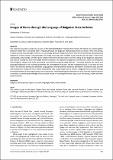Files in this item
Images of Roma through the language of Bulgarian state archives
Item metadata
| dc.contributor.author | Marinov, Aleksandar G. | |
| dc.date.accessioned | 2020-06-23T08:30:09Z | |
| dc.date.available | 2020-06-23T08:30:09Z | |
| dc.date.issued | 2020-06-04 | |
| dc.identifier | 268642455 | |
| dc.identifier | 367f8d5a-3ac2-43b3-99e8-c54dc402cd14 | |
| dc.identifier | 000539206300005 | |
| dc.identifier | 85090242843 | |
| dc.identifier.citation | Marinov , A G 2020 , ' Images of Roma through the language of Bulgarian state archives ' , Social Inclusion , vol. 8 , no. 2 , pp. 296-304 . https://doi.org/10.17645/si.v8i2.2787 | en |
| dc.identifier.issn | 2183-2803 | |
| dc.identifier.other | crossref: 10.17645/si.v8i2.2787 | |
| dc.identifier.uri | https://hdl.handle.net/10023/20123 | |
| dc.description.abstract | This research has been carried out as part of the RomaInterbellum Project which studies the Roma civic emancipation between World War I and World War II. Trawling through the Bulgarian archival documents on Roma in this time period, a reader cannot help but begin to form a certain image about the Tsigani, the term with which Roma have been popularly referred to in the archives. Unsurprisingly, this image does not seem to differ much from the one of today—that of the uneducated, dirty, foreign, and that pose a threat not only to the prosperity and well-being of the Bulgarian population and culture at large but also to the state and the economy. The research is based on archived files, letters of complaints from Bulgarian citizens and other documents sourced from Bulgarian state archives. The article analyses the words and language employed in the archived documents, the connotations they bear and the images they build. It also tries to show how, in the interwar period, this dominant language was utilised by Roma individuals and leaders in order to react, counter and protect their image and future. More importantly, they sought ways to build a better integrated Roma society through the establishment of own organisations and associations. Understanding this historical narrative from the interwar period is essential in advancing knowledge of many major issues surrounding the Roma today, such as housing, health and their social inclusion. | |
| dc.format.extent | 206596 | |
| dc.language.iso | eng | |
| dc.relation.ispartof | Social Inclusion | en |
| dc.subject | Bulgaria | en |
| dc.subject | Emancipation | en |
| dc.subject | Gypsy | en |
| dc.subject | Inclusion | en |
| dc.subject | Language | en |
| dc.subject | Roma | en |
| dc.subject | State archives | en |
| dc.subject | GN Anthropology | en |
| dc.subject | DR Balkan Peninsula | en |
| dc.subject | T-NDAS | en |
| dc.subject.lcc | GN | en |
| dc.subject.lcc | DR | en |
| dc.title | Images of Roma through the language of Bulgarian state archives | en |
| dc.type | Journal article | en |
| dc.contributor.institution | University of St Andrews. School of History | en |
| dc.identifier.doi | 10.17645/si.v8i2.2787 | |
| dc.description.status | Peer reviewed | en |
This item appears in the following Collection(s)
Items in the St Andrews Research Repository are protected by copyright, with all rights reserved, unless otherwise indicated.

